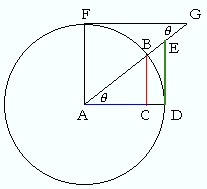Math 5
![]()
![]()
![]()
![]() Trigonometry Syllabus
Trigonometry Syllabus
![]()
![]() Fall ’08
Fall ’08
CLASS MEETINGS: MTWR 8:00 - 9:10 in ? INSTRUCTOR: Geoff
Hagopian |
 |
From the course outline:
Before entering the course you must be able to:
a. Interpret slope as a constant rate of change.
b. Recognize and create linearity in tables, graphs, and/or equations.
c. Solve systems of equations by using methods of elimination, substitution and graphing.
d. Graph and/or find the equation of a circle given sufficient information.
e. Solve quadratic equations by factoring, completing the square, and the quadratic formula.
f. Recognize and create quadratic models for relations involving tables, graphs, and equations.
g. Graph a parabola by finding the vertex, intercepts, and other symmetric points.
h. Demonstrate understanding of definitions for function and its related terms: domain and range.
i. Use appropriate notation for function equations and for describing domain and range.
j. Demonstrate understanding of the exponential function, its scaling and growth factors.
k. Understand how to solve similar triangle problems.
l. Demonstrate understanding of triangle congruency theorems involving SSS, SAS, AAS.
m. Basic knowledge about congruence relations such as the congruence of vertical angles
n. Familiarity with Pythagorean theorem.
o. Demonstrate understanding of deductive reasoning in the construction of a proof.
In this course we will:
a. Review plane geometry facts and applications of angles, triangles, quadrilaterals and circles.
b. Deductive reasoning and proofs.
c. Functions including 4 ways of representing functions, function-notation, terminology, rates of change, and representing word problems with functions.
d. Transformations of functions
e. The algebra of functions including the composition of functions.
f. One to one functions and inverse functions.
g. The trigonometric definitions using the right triangle and circular approach.
h. Solving triangles including right triangles, oblique triangles, Law of Sines, Law of Cosines, and applications.
i. Radian and degree measure including applications.
j. Trigonometric functions and their graphs, including phase shifts, amplitude, frequency, period, and translations.
k. Modeling periodic behavior using trigonometric functions.
l. Pythagorean Identities and using identities to deduce other identities.
m. Conic Sections including the basic characteristics of parabolas, circles, ellipses and hyperbolas, graphing and applications.
n. Parametric Equations including graphing a parametrically defined curve.
o. Vectors including analytic and geometric representations and applications.
9. Course Objectives: Upon completion of this course, students will be able to:
a. Apply facts about angles, parallel lines and triangles to deduce further results about a geometric figure.
b. Prove when two triangles are congruent or similar.
c. Justify the lengths of sides in an isosceles right triangle and in a 30-60-90 triangle.
d. Deduce the lengths of sides in quadrilaterals such as trapezoids and rectangles using basic definitions, Pythagorean Theorem, perimeter and/or area.
e. Calculate the measure of a central angle in a circle using the measure of the intercepted arc and calculate the areas of geometric figures involving circles.
f. Apply facts about plane geometric figures to deduce the surface area and volume of three dimensional geometric figures.
g. Demonstrate an understanding of the concept of a function by identifying and describing a function graphically, numerically and algebraically.
h. Calculate the domain and range for a function expressed as a graph or an equation. From a graph, estimate the intervals where a function is increasing, decreasing and/or has a maximum or minimum value.
i. Use and interpret function notation to find “inputs” and “outputs” from the graph, table and/or an equation describing a function
j. From an equation, graph or table, calculate average rates of change by using a difference quotient or by using slopes of secant lines. Analyze average rates of change to determine the concavity of a graph.
k. Demonstrate an understanding of the six basic transformations of functions by graphing translated functions including the quadratic functions.
l. Represent a word problem (especially a geometric problem) with a function.
m. Determine when a function has an inverse (one to one functions) and find the inverse function
graphically or algebraically.
n. Form new functions through addition, subtraction, multiplication, division and composition.
o. Recognize classical and analytic definitions of the trigonometric functions.
p. Solve triangles using right triangle trigonometry, the law of sines and the law of cosines.
q. Convert from radian to degree measure and vice-versa.
r. Graph the 6 trigonometric functions and demonstrate the ability to change parameters and predict corresponding graphic behavior.
s. Use trigonometric functions to model periodic behavior.
t. Use the basic Pythagorean identities to deduce further identities.
u. Recognize the basic features of the graphs of the conic sections (including parabolas, ellipses, circles and hyperbolas) and use those features to graph shifted conics.
v. Graph a function defined by parametric equations.
w. Represent quantities such as velocity and force with vectors using both a geometric and analytic description.
x. Apply vectors and the properties of vectors to solving problems involving force and navigation.
y. Analyze independently and set up application problems, thus applying problem solving technique to new situations. Demonstrate the ability to anticipate and check their proposed solutions.
z. Communicate effectively with the instructor and mathematical community using proper terminology verbally as well as proper written notation.
Return to Trigonometry syllabus.